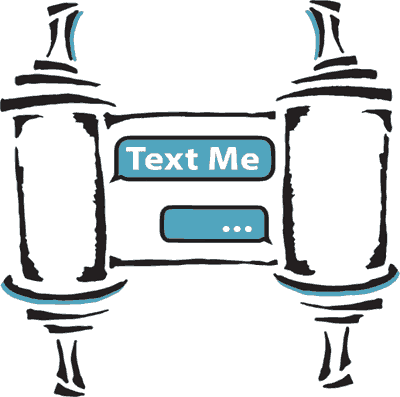Where do we fit in the “big picture” of technology and innovation as individuals, as members of western/world civilization, and as a member Jewish civilization? This activity is designed to facilitate such an exploration.
Below the educator will find a list of 24 technology revolutions. For the educator’s convenience the list is reproduced twice, once with dates and once without. An accompanying PDF file (courtesy of the Jewish Education Center of Cleveland) can be downloaded and reproduced to facilitate the activity.
Parchment
Torah Scroll
Compass
Gutenberg Press
Typewriter
Telegraph
Pony Express
Record Player
Electric Light Bulb
Rotary Phone
Black and White Television
Trip Tik Maps
Cordless Phone
Cell Phone
Walkman
Laptop
GPS
MP3 Player
Skype
Iphone
(with dates…)
Parchment (2,400 BCE)
Torah Scroll (1200 BCE if Sinai; 500 BCE if Palestine or Babylon)
Compass (1100)
Gutenberg Press (1454)
Typewriter (1843)
Telegraph (1844)
Pony Express (1860)
Record Player (1877)
Electric Light Bulb (1879)
Rotary Phone (1893)
Black and White Television (1923)
Trip Tik Maps (1934)
Cordless Phone (1968)
Email (1971)
Cell Phone (1973)
Walkman (1970)
Laptop (1980)
GPS (1989)
MP3 Player (1998)
Skype (2003)
iPhone (2007)
The list of innovations can and should be expanded. Various social media innovations (facebook, instagram) and inventions (apple watches, electric cars) can be added to the list.
It is useful to do a warm up before turning the groups loose. One can call out each innovation and have participants signal their relationship to the innovation. A thumbs up might indicate they have both heard of the innovation and utilized it, a thumbs down signals total unfamiliarity, and a hand hovering over ground that they have heard of it but have no personal familiarity.
Typically, this activity is done by breaking a larger group into smaller teams. Each team is given a packet of images of the revolution/invention. Their primary task is to create a time line. “Straight up” this is done without any access to online information through phones or computers. If there is adequate time for processing one can vary the assignment for each group e.g., one group no devices, a second group access to devices from beginning, a third group access after trying to create the time line through their collective knowledge. This process can often be an interesting mirror to all we’ve lost and all we’ve gained in the digital age. Access to information immediately can be weighed against the virtues of collaboratively creating guiding knowledge maps.
Some other dimensions of processing would be …
1. Inviting people to talk about their first encounter with one of the innovations. What was exciting, novel, even forbidding about it when they encountered it?
2). Generate a sense of the pace of technological innovation over time. Ask group to guess at the length of time that separates innovations 1 thru 15. How long a period is covered in the last six innovations? Discuss what the different pace of innovation might mean.
3). Challenge the group to take three sets of two different stick em dots. Their job: place one color dot over the three innovation that in their judgement had the greatest impact on word civilization. The other three dots on the three innovations that most impacted Jewish life and civilization. How do they account for the differentiated impact?
4). There will likely be controversy around the dating of specific innovations. The time line of the groups might be different in ways that can’t be explained by one group having the right answer and the other the wrong one. The group might explore then the differences between when something is invented, when it is copyrighted and when it is made popular and widely accessible
5. This exercise can be a springboard to celebrating technology and its positive impact on Jewish life. Below is a description of a project developed for 8th graders at Heilicher Minneapolis Jewish Day School.
It turns out that there is a tradition of communities declaring a “special Purim” (complete with a megillah scroll) when they have been delivered from extreme danger.There are several hundred such Special Purims recorded in the Encyclopaedia Judaica.
Your team challenge will be to connect the advent of a new technology from our with your choice of a special brachah/blessing and the declaration of a special Purim. You will need to develop a skit, song, or video that shows how your chosen technology once saved a segment of the Jewish people from great danger (or alternatively greatly enriched their lives). Remember this is done in the spirit of Purim; imagination and fantasy can outweigh facts and actual history here.
